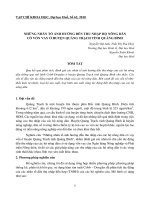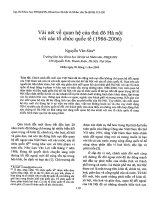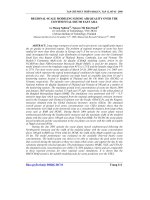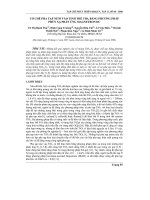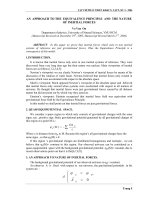Báo cáo nghiên cứu khoa học: " AN APPROACH TO THREE CLASSICAL TESTS OF THE GENERAL THEORY OF RELATIVITY IN THE VECTOR MODEL FOR GRAVITATIONAL FIELD" docx
Bạn đang xem bản rút gọn của tài liệu. Xem và tải ngay bản đầy đủ của tài liệu tại đây (311.88 KB, 7 trang )
TAẽP CH PHAT TRIEN KH&CN, TAP 10, SO 03 - 2007
Trang 5
AN APPROACH TO THREE CLASSICAL TESTS OF THE GENERAL THEORY OF
RELATIVITY IN THE VECTOR MODEL FOR GRAVITATIONAL FIELD
Vo Van On
University of
Natural Sciences, VNU-HCM
(Manuscript Received on July 05
th
, 2006, Manuscript Revised November 27
th
, 2006)
ABSTRACT: In this paper, based on the vector model for gravitational field we have found a
metric tensor of the space time that in the first order approximate it lead to the Schwarzschild metric
tensor in the General Theory of Relativity(GTR). Thus, we have also obtained 3 classical tests of GTR in
the Vector Model for Gravitational Field.
1.INTRODUCTION
We have known that when using the equivalence principle in a very direct way, Einstein made the
first derivation of the red shift which appropriated good with experiments and he also predicted the
deflection of the light rays in the gravitational field of the Sun but it only approached half of the
experimental value.
Some authors as R. Adler , M. Bazin and M. Schiffer[1]; Frank W.K.Firk[2] obtained the
Schwarzschild metric tensor in the context of special relativity by using the equivalence principle ,
however these approaches were difficult to understand.
In this paper, based on the vector model for gravitational field and the Special relativity, we have
found the metric tensor of the space time that in the first order approximate it leads to the
Schwarzschild metric tensor in GTR. This approach is a clear deduction. Thus, we have also obtained 3
classical tests of GTR in the Vector Model for Gravitational Field.
2. SPACE AND TIME IN NON-INERTIAL REFERENCE FRAMES AND IN
GRAVITATIONAL FIELD
It is known that [3, 4] time is uniform and space is both uniform and isotropic in inertial frames of
reference. The geometrical properties of uniform and isotropic space can be described by Euclidean
geometry.
In uniform and isotropic space, the length of line segments do not depend upon the region of space
they are in. We divide the axes of coordinates into equal segments x = y =l and draw straight lines,
parallel to the axes, through the points of division. Plane xy is thus divided into unit cells (fig.1, fig.2) in
the form of equal squares.
In exactly the same way, owing to the uniformity of time in an inertial reference frame, the interval
of time t between two events is independent to the point of space at which these events occur.
Space is non-uniform in a non- inertial reference frame. Indeed, we know that the length of a line
segment is less in a moving frame than in one in which the line segment is at rest:
2
2
1
c
v
xx =
(1)
But in motion with constant acceleration
axv 2
2
= , where a is the acceleration of the non-inertial
frame of reference , we obtain[3] :
2
2
1
c
ax
xx =
(2)
Science & Technology Development, Vol 10, No.03 - 2007
Trang 6
We see that in non-inertial frames of reference, the length of a line segment depends upon the region
of space it is located in. The length of the same line segment differs at points with different abscissae.
Fig.1 Fig.2
But a line segment along the axis y retains unchanged length because (in our case) there is no motion
along this axis: Δy’= Δy
Space is not only non-uniform in a non-inertial reference frame but is anisotropic.
Indeed, the two directions are not equivalent along the axis of abscissas. In our example, elements of
length decrease along the positive direction of axis and increase along the negative direction.
It should be noted that the laws of conservation of linear and angular momentum do not hold in non-
inertial reference frames due to the non-uniformity and anisotropy of space in these frames.
Finally, it can also be shown that time is non-uniform in non-inertial reference frames, as a result, the
law of conservation of energy does not hold for such frames.
In a moving reference frame, an interval of time between two events occurring at the same point is :
2
2
1
c
v
t
t
−
Δ
=
′
Δ
(3)
Making use, as above, of the expression
axv 2
2
= , we obtain[3]:
2
2
1
c
ax
t
t
−
Δ
=
′
Δ
(4)
Because of the non-uniformity and anisotropy of space in non-inertial reference frames, it is
necessary to describe properties of such space by means of a non-Euclidean geometry.
From the previous papers[5,6], we see that inertial force field is just gravitational force field,
therefore space –time in a gravitational field (as in a field of inertial forces) is non- Euclidean.
3. MOTION OF BODIES IN A GRAVITATIONAL FIELD
Consider a particle moving freely under the influence of purely gravitational forces. Because inertial
forces are just gravitational forces in non-inertial reference frames [5,6], there is a freely falling
coordinate system ξ
α
in which equation of motion of this particle is that of straight line in space –
time[4]. This means:
0
2
2
=
τ
ξ
α
d
d
(5)
x
y
x
y
TAẽP CH PHAT TRIEN KH&CN, TAP 10, SO 03 - 2007
Trang 7
Where d is the proper time. With:
ddd =
2
(6)
Where:
If we now use any other coordinate system x
, which can be a Cartesian coordinate system at rest in
the laboratory, but also may be curvilinear, accelerated, rotating , The freely falling coordinates
are
functions of the x
, and Eq.(5) becomes:
)(0
d
dx
x
d
d
=
d
dx
d
dx
x
x
d
xd
x
+
=
2
2
2
Multiply this by
x
, and use the familiar product rule:
=
x
x
This gives the equation of motion:
d
dx
d
dx
d
xd
+=
2
2
0 (7)
Where
is the affine connection, defined by:
xx
x
2
(8)
The proper time (6) may also be expressed in an arbitrary coordinate system:
dx
x
dx
x
d
=
2
or
dxdxgd =
2
(9)
Where g
is the metric tensor, defined by:
x
x
g
(10)
For mass-less particles the right-hand side of (6) vanishes. Instead of we can use
0
, so that (7)
and (9) become:
d
dx
d
dx
d
xd
+=
2
2
0 (11)
+1 if =
= 1,2,3
-1 if =
=0
0 if
=
Science & Technology Development, Vol 10, No.03 - 2007
Trang 8
σσ
νμ
μν
d
dx
d
dx
g=0
(12)
We also recall the relation between g
μν
and
λ
μν
Γ as follows [1,4,7]:
}{
2
1
ν
μλ
μ
λν
λ
μν
νσσ
λμ
x
g
x
g
x
g
g
∂
∂
−
∂
∂
+
∂
∂
=Γ
(13)
We also see the case of a particle moving slowly in a weak stationary gravitational field, (7) becomes
the corresponding Newtonian equation:
φ
−∇=
2
2
d
t
xd
(14)
If we have: g
00
=-(1+ 2φ). We also note that equation (7) just is the equation of the geodesic in the
curved space-time with the metric tensor g
μν
.
4. AN APPROACH TO THE METRIC TENSOR OF SPACE-TIME WITH THE PRESENT OF
THE GRAVITATIONAL FIELD
In this section, we introduce an approach to the Schwarzschild metric tensor, it is similar to an
approach from the equivalence principle of different authors [1,2].
Suppose that we want to seek the interval of events attached to a particle which moves in a
gravitational field of M
g
. To realize this, we should displace a standard ruler and a standard clock along
the orbit of the particle.But when the ruler and clock move along the orbit in the gravitational field, the
length of ruler and rate of the clock vary at each point. Because of this reason, the measured results at
each point in the gravitational field can not be compared together if we do not know any relation
between the etalons at each point. Seeking this relation between etalons, then we convert measured
results at each point with its etalons into measured results with the standard etalon is the synchronizing
of the rulers and the clocks as the synchronizing of clocks in the special theory of relativity.
Firstly, we seek the relation between etalons at each point then convert the measured results.
We choose the length of a ruler and rate of a clock at a point O which is very distance from the field
source, say l
0
and τ
0
, as a standard etalon. The gravitational potential is the cosmic background potential
ϕ
g0
at this point.
We suppose that there is every locally Minkowskian coordinate system at each point in a
gravitational field. This hypothesis agrees the axiom which Gauss took as the basis of non-Euclidean
geometry. Gauss assumed that at any point on a curved surface we may erect a locally Cartesian
coordinate system in which distances obey the law of Pythagoras. This hypothesis also is a part of the
equivalence principle [4].
We find the interval of two events near a point N(r) in the gravitational field with the local etalon at
N(r) as follows:
)sin(
22222222
ϕθθ
ddrdrdtcds +−−=
(15)
Now we seek the expression of the interval (15) if it is measured by the standard etalon l
0
,τ
0
. Firstly,
we seek the relation between etalons (l
0
,τ
0
) and etalon (l,τ). Consider two observers A and B, their
etalons are the same. Observer A is rest with respect to the cosmological background potential ϕ
g0
.
Observer B moves with respect to it with velocity of v= at in x direction (the vertical direction). We have
the following relations from the special theory of relativity:
TAẽP CH PHAT TRIEN KH&CN, TAP 10, SO 03 - 2007
Trang 9
2
2
0
1
c
v
g
g
=
(16)
Where
g
is the gravitational potential on the system of B.
)(1)(
2
2
verticall
c
v
verticall
AB
=
(17)
)()( horizontallhorizontall
AB
=
(18)
2
2
1
c
v
A
B
=
(19)
From (16), (17) and (19) we have :
)()(
0
verticallverticall
A
g
g
B
= (20)
A
g
g
B
0
=
(21)
Where
0g
is the gravitational potential in the system A;
g
is the gravitational potential in the
system B.
Now we return the above problem. The gravitational potential at O is the cosmological background
potential
0g
, the gravitational potential at N(r) is:
gggN
+=
0
(22)
Where
g
is the gravitational potential of M
g
at N(r).
We see that the potential
g
causes the gravitational field on the system B and we have the relations
(20), (21) between the etalons at A and B. In a similar case, the potential
N
g
causes the gravitational
field at N so we also have the relations (20) and (21) between the etalons at N and A
From (20), (21) we have the relation between etalons at O and N is:
)()(
0
0
verticallverticall
gN
g
=
(23)
0
0
g
gN
=
(24)
From (23) and (24) we have the relations between the interval of length and the interval of time at O
and N are:
0
0
drdr
g
gN
= (25)
Science & Technology Development, Vol 10, No.03 - 2007
Trang 10
0
0
dtdt
gN
g
ϕ
ϕ
=
(26)
Substituting (25), (26) into (15) we obtain:
)sin()()(
2222
0
2
0
2
0
2
0
2
0
22
ϕθθ
ϕ
ϕ
ϕ
ϕ
ddrdrdtcds
g
gN
gN
g
+−−=
(27)
Note that we still have r = r
0.
Noting (22), we have:
2
00
0
0
11
c
g
g
g
g
gg
g
gN
ϕ
ϕ
ϕ
ϕ
ϕ
ϕ
ϕ
ϕ
−=+=
+
= (28)
We have had
2
0
c
g
−=
ϕ
from the previous paper [6]. Substituting (28) into (27), we obtain:
)sin()1()1(
2222
0
2
0
2
2
2
0
2
2
22
ϕθθ
ϕ
ϕ
ddrdr
c
dt
c
cds
gg
+−−−−=
−
(29)
For
2
c
g
ϕ
<< 1, we have:
)sin()21()21(
2222
0
2
0
2
2
0
2
22
ϕθθ
ϕ
ϕ
ddrdr
c
dt
c
cds
gg
+−−−+=
(30)
With
r
GM
g
g
−=
ϕ
, we obtain from (30):
)sin()21()21(
2222
0
2
0
2
2
0
2
22
ϕθθ
ddrdr
rc
GM
dt
rc
GM
cds
gg
+−+−−=
(31)
(31) is just the Schwarzschild solution in GTR.
From the metric tensor (31) and equations (7),(11),(12) we find the classical three tests of GTR.
5. CONCLUSION
In conclussion, based on the vector model for gravitational field we have obtained the metric tensor
of the space-time (29). This metric tensor leads to the Schwarzschild metric tensor in a weak
gravitational field, therefore we have also obtained three classical tests of GTR in the Sun system. In a
strong gravitational field, the metric tensor (29) is different with the Schwarzschild metric tensor and it
gives the small suplementations to these three classical tests.
TAẽP CH PHAT TRIEN KH&CN, TAP 10, SO 03 - 2007
Trang 11
MT TIP CN N 3 HIU NG KINH IN CA THUYT TNG I TNG
QUT TRONG Mễ HèNH VECT CHO TRNG HP DN
Vừ Vn n
Trng i hc Khoa hc T nhiờn, HQG-HCM
TểM TT: Trong bi bỏo ny khi da trờn mụ hỡnh vộct ca trng hp dn, chỳng tụi thu c
mt tenx mờtrớc ca khụng thi gian m trong gn ỳng bc nht nú dn n tenx mờtrớc
Schwarzschild trong Thuyt Tng i Tng Quỏt (GTR). Nh vy, 3 kim tra kinh in ca GTR trong
h mt tri cng tỡm li c trong mụ hỡnh hp dn vộct ny.
REFERENCES
[1]. R. Adler, M. Bazin, M. Schiffer, Introduction to General Relativity. McGraw-Hill Book
Company, (1965)
[2]. Frank W. K. Firk, ESSTENTIAL PHYSICS (part 1): Relativity, Particle Dynamics, Gravitation
and Wave Motion, Yale University Publisher, (2
000).
[3]. B.M.Yavorsky & A.Pinsky,Fundamentals of Physics, Vol.1(1975)
[4]. S.Weinberg, Gravitation and Cosmology: Principles and Applications of The general theory of
Relativity. John Wiley & sons (1972)
[5]. Vo Van On, A Vector Model for Gravitational Field, Journal of Technology & Science
Development. Vietnam National University Ho Chi Minh city, April (2006).
[6]. Vo Van On, An Approach to the Equivalence Principle and The Nature Of Inertial Forces.
Journal of Technology & Science Development. Vietnam National University HoChiMinh
city, May (2006).
[7]. Nguyen Ngoc Giao, The Theory Of Gravitational Field ( The General Theory Of Relativity),
library of University of Natural Sciences, Ho Chi Minh city in Vietnamese, (1999).
[8]. A.Einstein, The Meaning of Relativity, Princeton University Press, Princeton, N.J., (1946).


